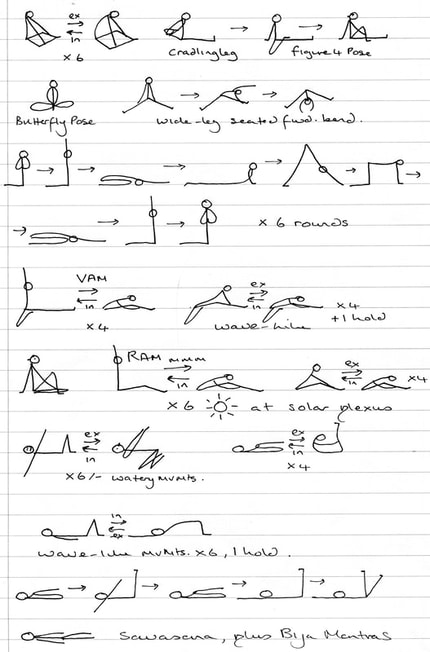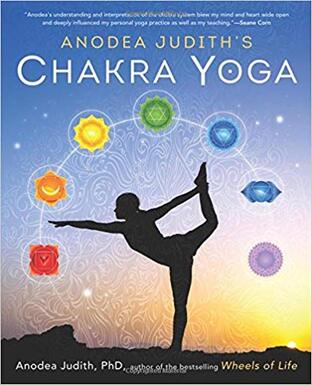|
This week in class we're focusing on the second chakra, Svadhisthana. The element associated with this chakra (subtle energy centre) is water and it helps us develop a sense of flow. When this chakra is in balance everything flows well; our body, circulatory system, our thoughts and feelings, how we relate to others, and our ability to go with the flow of life. Over the past few weeks in class we've been focusing on the first, base chakra, Muladhara. Its element is earth, which has helped us to develop a sense of rootedness and being grounded. We are now going to build on those strong rooted foundations to develop a sense of flow. So when you do the Svadhisthana Flow yoga practice pictured below keep in mind those two words: root and flow. In the practice below we use watery flowing movements, with a focus on wave-like breathing. We also place our awareness in the lower belly, which is the area that is associated with this chakra. We use the bija mantra VAM (pronounced VUM), in some of our yoga poses, sometimes sounding it and other times silently. The pin-people below were just intended as an aide-memoire for me, so excuse the unpolished nature of them. It's beyond the scope of this blog to give detailed instructions for the practice. However, the drawings below will help jog your memory about what we've been doing in class, in case you want to try the practice yourself at home. Enjoy! I became fascinated with the chakras in the early part of the millennium. Below are some of the notes I made on the second chakra in preparation for teaching a course on the chakras. When I'm exploring a subject I find it useful to jot down all my thoughts (brain storm or blue-sky thinking) to get my ideas flowing. I hope this blog post whets your appetite for creatively exploring the chakras in your own yoga practice or in your teaching.
1 Comment
What supports you in your life? What gives you the strength to live a heart-felt and authentic life? This week in class we have been focusing on Muladhara Chakra, the subtle energy centre that helps you to create strong and stable foundations, both physically, mentally, emotionally, spiritually, and in very practical ways in your daily life. Muladhara Chakra is also known as the foundation or root centre. The bodily parts associated with it are the legs, feet, the pelvic floor, and the sexual organs. Its associated element is earth. In your yoga practice you can work with Muladhara by focusing on where your body is in contact with the floor, relaxing into the support of the earth beneath you, and rising up from that strong, stable foundation. Below is my aide memoire for the Muladhara Chakra yoga practice that I created over the holidays. Please excuse the unpolished nature of the drawings as originally they were intended for my eyes only. However, for those of you attending my yoga classes, they will help jog your memory about what we did in class this week, just in case you want to try it out at home. Another way of invoking the earthy energy of this chakra is to bring images of the natural world into your yoga practice. For example this week in class we visualised images of spring flowers such as crocuses, snowdrops, or early daffodils, coming into bloom. In supine Tree Pose (Vrksasana) we pictured a tree that we felt a connection with. In Mountain Pose (Tadasana) we pictured the strength and stability of a majestic mountain. Recently I've really enjoyed reading Anodea Judith's Chakra Yoga. Other chakra themed books that I recommend are: The Book of Chakra Healing, by Liz Simpson, and Chakra Workbook by Pauline Wills. I hope like me that you will find the chakras provide you with a real treasure trove of creativity and inspiration.
|
AuthorThis occasional blog is designed to share my yoga class handouts, resources, and tips with my yoga classes. Archives
November 2023
Categories |







 RSS Feed
RSS Feed